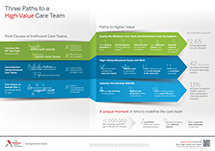At our annual System Chief Nurse Executive Roundtable, we strive to provide a forum for system CNEs to discuss some of the most pressing issues in health care and to identify the specific role system nurse executives should play in overcoming those challenges.
This year, our agenda focused on two areas:
- Playbook for population health: Building a framework for developing a high-performing care management network with distinct strategies for three patient populations: high-, rising-, and low-risk patients.
- Designing the interprofessional care team for accountable care: How best to re-think care teams to simultaneously advance multiple aims, including integrating patient care, improving care outcomes, and streamlining labor costs.
Here are the nine most important takeaways drawn from this year's meeting.
To participate in a future roundtable, Nursing Executive Center members can register for our upcoming national meeting series.
Jump to a Strategy
1. The patient-centered medical home (PCMH) is not a one-size-fits-all model.
While the PCMH can be a highly effective model for some patient groups, it may be insufficient or overly comprehensive for others.
2. Successful population health managers prevent the escalation of rising-risk patients.
Many organizations focus their care management efforts on their highest-cost, highest-risk patients, but population health managers must also focus efforts on rising-risk patients.
3. Leading population health managers minimize physical encounters for healthy patients while increasing patient loyalty.
Creating lower-intensity staffing models and using technology can be crucial to providing convenient, low-cost access points that meet the needs of lower-acuity patients.

Three paths to a high-value care team
4. Health systems don't need to own all cross-continuum services to provide integrated care.
In some cases, it can be more effective to partner with other organizations that already offer key services, rather than develop and deploy them internally.
5. High-functioning, interdisciplinary care teams share meaningful performance goals.
Leaders must ensure that all care team members have a set of shared outcomes-based goals that cascade from the system's strategic plan to the point of care.
6. Nurse leaders should elevate ambulatory nursing as a career destination for high-performers.
Historically, fee-for-service models incented nurse leaders to keep high performers in acute care settings, but this is changing for three reasons.
7. The primary care provider of choice depends on the patient's needs.
Leaders should strive to match individual patient needs with the strengths of the clinician providing care.
8. Providers should resist labeling any patient as "non-compliant."
Rather than putting fault with the patient, providers should hold themselves accountable for ensuring patients are fully equipped to manage their care.
9. Using "hours per patient day" (HPPD) alone to measure nursing productivity limits flexibility in care team design.
Staffing solely to HPPD targets inhibits better deployment of the increasingly diverse patient care workforce.
Don't miss out on the latest Advisory Board insights
Create your free account to access 2 resources each month, including the latest research and webinars.
Want access without creating an account?
You have 2 free members-only resources remaining this month remaining this month.
1 free members-only resources remaining this month
1 free members-only resources remaining this month
You've reached your limit of free monthly insights
Become a member to access all of Advisory Board's resources, events, and experts
Never miss out on the latest innovative health care content tailored to you.
Benefits include:
You've reached your limit of free monthly insights

